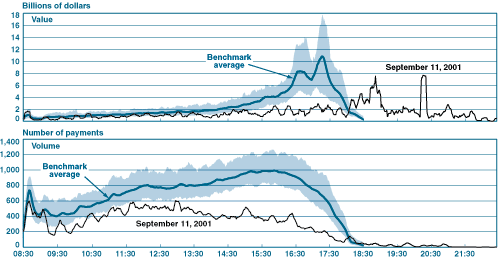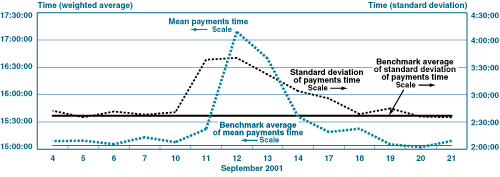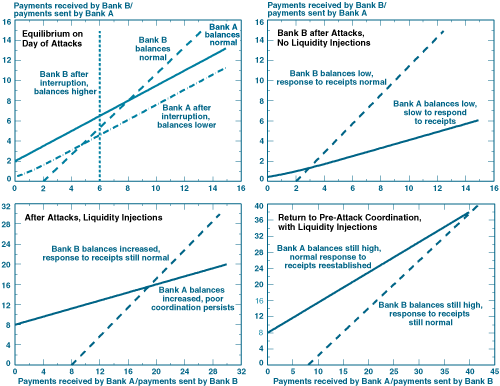|
Overview
McAndrews and Potter investigate the disruption to the flow of payments among banks on September 11 and assess the steps taken by the Federal Reserve to remedy the problem. They find that the Fed’s moves to supply extraordinary amounts of liquidity to the banking system were important in restoring normal payments flow.
Background
Because of the severe damage to property and communications systems on September 11, some banks were unable to execute payments through the Federal Reserve System’s large-value payments system, Fedwire. As a result, other banks received fewer payments than expected. Since banks rely heavily on a strategy of payments coordination—using incoming payments to fund their own transfers—those banks that found themselves short of liquidity were less likely to send payments to other banks in the normal pattern.
Argument and Methodology
The authors begin their analysis by tracking changes in the value and volume of Fedwire transfers on September 11 and the days following. Payments fell off sharply on the day of the attack: Instead of the usual $10 billion per minute that flows over the wire near the end of most days, the end-of-day flow on September 11 was less than $2 billion per minute (chart). Although the value of funds sent returned to normal levels on September 12, the volume of payments remained low until September 14. The authors also show that the timing of payments deviated markedly from the customary patterns. The variability of payments timing rose sharply—almost doubling to about four hours from two—and payments were delayed by roughly two hours on average (chart). In this environment, banks were unsure when they would receive expected payments and whether they would be able to synchronize their outgoing payments with incoming funds from other banks. Banks responded to the uncertainty, the authors argue, by increasing their precautionary demand for liquidity. To test this interpretation, the authors estimate banks’ payments reactions to the receipt of payments from other banks. Using data on the Fedwire activity of twenty large banks, they assess banks’ propensity to send out payments in response to incoming payments both before and after September 11. They find a distinct shift after September 11, with the typical bank requiring more of a liquidity cushion in advance of sending out payments than it had in the preceding period. The authors then show how the Federal Reserve’s actions to meet banks’ demand for liquidity helped to reestablish payments coordination. Specifically, the Fed lent billions of dollars through the discount window—more than two hundred times the daily average amount of lending in the prior month—and temporarily suspended penalties on intraday and overnight overdrafts. These actions reduced banks’ reliance on payments from other banks and encouraged banks to resume sending their payments in more normal patterns. In the week of September 17-21, the Fed injected additional liquidity into banks’ accounts through open market operations, bringing payments coordination to higher than normal levels (chart).
Findings
The breakdown in the coordination of payments on September 11 caused the demand for liquidity to balloon. McAndrews and Potter argue that the Fed’s moves to meet this demand through discount window loans and open market operations helped to reestablish the coordinating equilibrium. According to the authors, the discount window proved to be a particularly effective means of channeling liquidity to those institutions that needed funds in order to send payments.
The authors conclude their analysis with a brief look at long-run reforms that could mitigate the impact of future disruptions to the payments system. They discuss current proposals for safeguarding the physical infrastructure of the system and examine possible changes in the protocols for submitting and settling payments.
|













